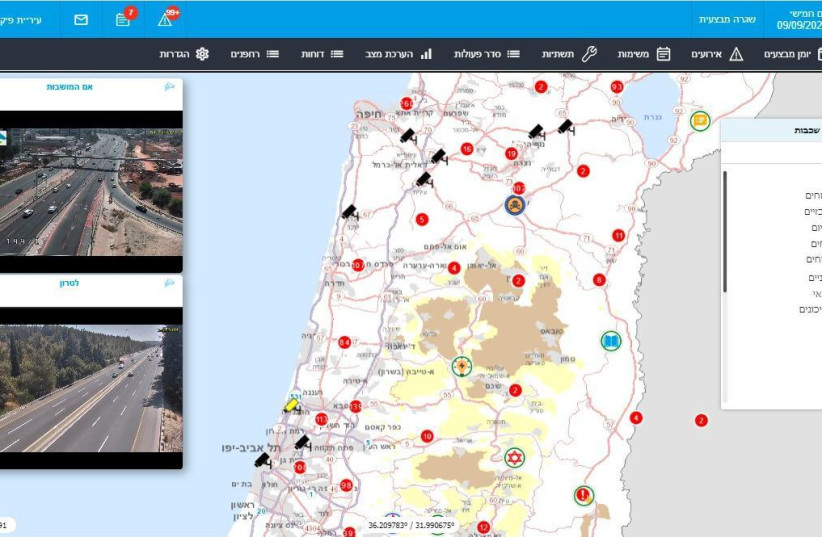The IDF’s Home Front Command has two life-saving programs that are up for contention for the Chief of Staff Medal of Appreciation.
One system, dubbed Shual (the Hebrew acronym for National Home Front Command and Control), is a nationwide geographic database designed to allow local authorities, first responders and the Home Front Command to receive all pertinent information in real time, providing them with a clear picture of the unfolding emergency situation.
The system has already been installed in over 100 municipalities and will soon be in every city in Israel, Capt. Nir Eldan, the head of the HFC’s Shual program branch told The Jerusalem Post.
“The system was placed in 100 municipalities quickly and we gave a full four months of training on it over the past year because of corona,” he said, adding that though “it costs millions of shekels, it needs to go to every city in the country.”
That’s because “90% of incidents take place in residential areas. That’s where the enemy is aiming.”

Take, for example, a rocket striking a residential building in the city of Ashkelon during a round of violence between Israel and Hamas; instead of needing to find the first responders and other rescue teams, municipalities will be able to see their exact location using Shual on a map.
The maps can be seen in two or three dimensions. Decision-makers can also zoom into the street level to see a clear picture of the incident.
The command and control system database has all the locations of first responders, the status of local authorities, and other critical information needed during emergencies using geographic information system software.
“In order for real-time intelligence to be accurate, we need to have a geographic information system, big data, aerial maps and other aerial pictures,” Eldan said.
The integrative system developed by the Command links authorities and other agencies with affected municipalities allowing them to formulate a uniform picture, manage critical resources as well as perform a risk assessment of the situation as it unfolds.
Though it’s a national system, each municipality has its own polygon and is only able to see its own polygon. But in addition to local authorities, government ministries also have access to the system and are able to see where municipalities might be struggling and need assistance.
Shaul uses a cloud network to enable national coverage and according to Eldan, it is the HFC that is responsible to defend the system against cyberattacks.
The Shual has also been used by the Home Front Command when it was dispatched abroad on various search and rescue missions, including in the Surfside neighborhood of Miami, Florida, when a team flew to help deal with a collapsed building.
Israel has often aided countries struck by natural disasters, sending teams from the IDF Medical Corps and Home Front Command to provide search and rescue and medical aid in field hospitals in countries such Brazil, Mexico, Haiti, the Philippines, Japan, Turkey, Nepal and more.
The system, along with another HFC platform up for the Chief of Staff Medal of Appreciation dubbed Maya, helped troops get an aerial picture of the area before they even landed in Miami and while they worked the system used cellphone transmissions to find those trapped below.
Before the 10 person delegation led by Col. Golan Vach landed in Miami, they studied the building and built 3D models of the complex before they replicated the way the tower collapsed into four parts, from the center to the sides and then onto itself.
“When a building collapses, not everyone dies right away, but when a building collapses like a pancake such as in Miami there’s less chance of finding survivors,” a senior HFC officer told The Jerusalem Post.
The team worked side-by-side with American and Mexican teams in a search-and-rescue mode. According to a senior HFC officer, the ability to see the big picture and tie it together with the disaster scene helped find the bodies of missing people.
Troops also spoke with the families of the missing in order to understand where in their apartments they could have been when the building collapsed and family members were also asked to describe what the missing could be wearing, what color hair they have, and if they had any tattoos.
“Even the simplest things, when asked right and to the right person, makes all the difference,” the officer said.
Maya, he said, “enables us to take all relevant intelligence surrounding the event and then connect it to all the intelligence given by locals to get precision information for the application. It’s a sort of tango that everyone wants to dance with.”
Unlike Shual which has been used mainly in Israel, Maya has been used mostly abroad such as in Equatorial Guinea, Honduras, Albania, Brazil, and Cyprus.
“The mix of dozens of years of experience alongside the technology that brings the intelligence gives us a significant boost,” said the officer.
But both applications not only provide insight to those tackling emergencies, but they save lives and bring closure to families who lost loved ones. And that’s why both the Shual and Maya are up for the Chief of Staff Award.
